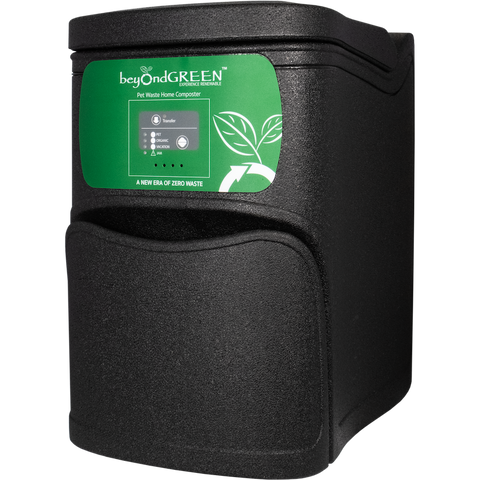Composting is a natural process that turns organic waste into nutrient-rich soil. It's an environmentally friendly way to dispose of kitchen scraps and yard waste, and it also helps reduce greenhouse gas emissions.
While traditional composting methods involve manual labor and can take months to produce usable compost, electric composters offer a more efficient and convenient solution. In this article, we'll dive into the basics of composting, how electric composters work, and the benefits of using this composting equipment.
Composting Basics
Before we delve into the specifics of electric composters, let's first understand the basics of composting. Composting is the process of breaking down organic materials, such as kitchen waste, leaves, and grass clippings, into a nutrient-rich soil amendment. This process is carried out by microorganisms, such as bacteria and fungi, which break down the organic matter into smaller particles.
Composting requires four main components: organic matter, moisture, oxygen, and microorganisms. The organic matter provides the food source for the microorganisms, while moisture and oxygen are necessary for their survival. The microorganisms break down the organic matter, producing heat as a byproduct. This heat is what speeds up the composting process and helps kill off any harmful pathogens.
How Do Electric Composters Work?
Electric composters, also known as electric composting machines, are a type of composting equipment that uses electricity to speed up the composting process. These machines are designed to mimic the natural composting process but at a much faster rate. They work by creating the ideal environment for microorganisms to thrive, resulting in faster decomposition of organic matter.
Step 1: Loading the Composter
The first step in using an electric composter is to load it with organic waste. This can include food scraps, yard waste, and even paper products. It's important to note that not all organic materials are suitable for composting, so it's best to do some research before loading your composter.
Reference our complete list of what you can and can not compost for details.
Step 2: Adding Bulking Agents
Bulking agents, such as wood chips or shredded newspaper, are added to the composter to provide structure and aeration. These agents help create air pockets within the compost, allowing oxygen to reach the microorganisms and promoting faster decomposition.
Step 3: Mixing and Shredding
Once the composter is loaded, it's time to mix and shred the organic waste. This is done by turning on the machine, which uses rotating blades to mix and shred the materials. This step helps break down the organic matter into smaller particles, making it easier for the microorganisms to digest.
Step 4: Heating and Aeration
As the organic matter is mixed and shredded, the composter also heats up the materials. This heat is essential for the microorganisms to thrive and break down the organic matter. The composter also provides aeration by blowing air into the compost, ensuring that the microorganisms have enough oxygen to survive.
Step 5: Composting Cycle
The composting cycle can take anywhere from a few hours to a few days, depending on the type of composter and the amount of organic waste loaded. During this time, the composter will continue to mix, shred, heat, and aerate the compost, creating the ideal environment for microorganisms to thrive.
Step 6: Finished Compost
Once the composting cycle is complete, the composter will stop mixing and shredding the materials. The finished compost will be dark, crumbly, and have an earthy smell. It's important to let the compost cool down before using it in your garden or adding it to your soil.
Benefits of Using Electric Composters
Electric composters offer several benefits over traditional composting methods. Let's take a look at some of the advantages of using this composting equipment.
Faster Composting
The most significant benefit of using an electric composter is the speed at which it produces compost. While traditional composting methods can take months to produce usable compost. Electric composters are able to complete this process in as little as a few hours or days. This is because the machine creates the ideal environment for microorganisms to thrive, resulting in faster decomposition.
Convenient and Easy to Use
Electric composters are also incredibly convenient and easy to use. Unlike traditional composting methods, which require manual labor and regular turning of the compost pile. The electric composters reduce the amount of attention needed by being completely automated.
Space-Saving
Electric composters are also space-saving, making them ideal for those with limited outdoor space. These machines are compact and can be placed on a balcony, patio, or even in a small backyard. This makes them a great option for urban dwellers who want to compost but don't have the space for a traditional compost pile.
Reduced Odor and Pests
Traditional composting methods can sometimes result in unpleasant odors and attract pests. Electric composters, on the other hand, are enclosed and have a filtration system that helps reduce odors. The high heat produced during the composting process also helps kill off any harmful pathogens, making it less attractive to pests.
beyondGREEN Electric Composters

If you are in the market for an electric composter, then beyondGREEN has a couple of options for you to choose from. We offer a kitchen composter that can be placed conveniently on your kitchen counter. As well as an organic waste and pet waste composter that you can use to compost pet waste.
Both of these composters are great options to make the composting process fast and efficient in your household. Our composters come with everything you need to get started with composting including baking soda and a box of sawdust pellets.
With our composters, you will be able to compost up to 5 lbs of food or pet waste per day and a 4-gallon per week capacity!



0 comments